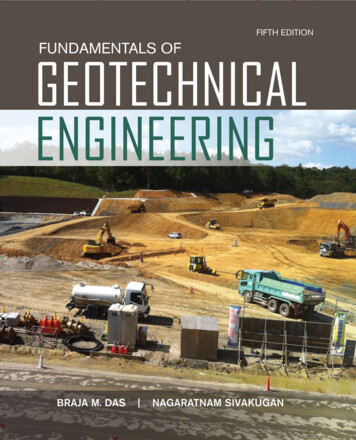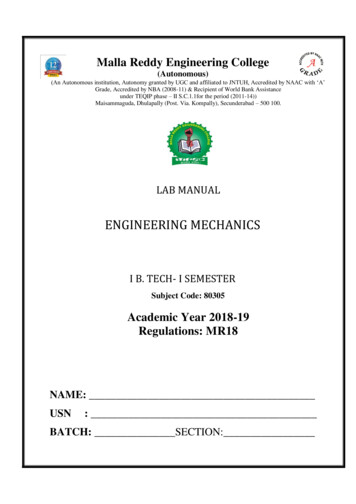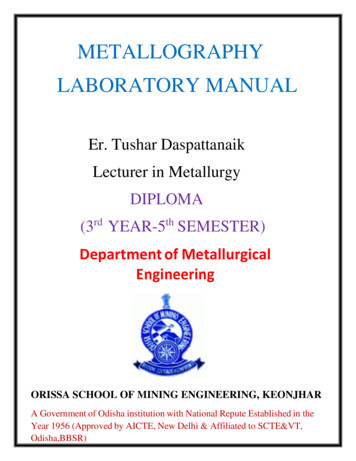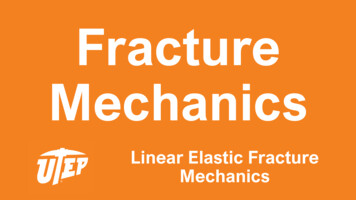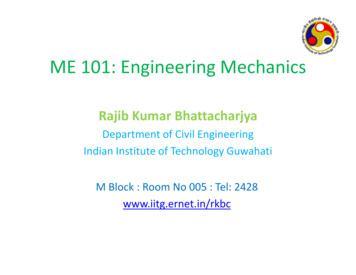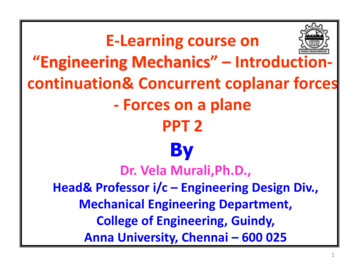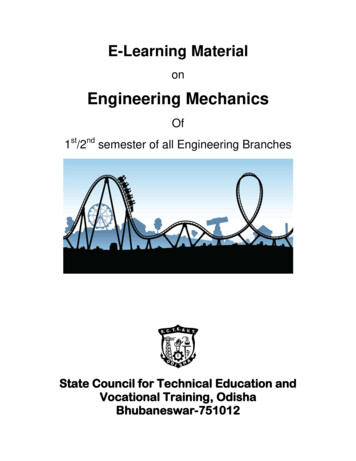
Transcription
E-Learning MaterialonEngineering MechanicsOf1st/2nd semester of all Engineering BranchesState Council for Technical Education andVocational Training, OdishaBhubaneswar-751012
E-Learning MaterialEngineering Mechanicsof1 /2 semester of all Engineering Branches of Diploma courses ofSCTE&VT, OdishastndContents Written bySRI SOUMYA RANJAN MISHRASRI THAKURA HANSDAHSRI KALEBAR SINGHMISS MONALISHA SWAINLECTURER, UGIE RKLLECTURER, UGIE RKLLECTURER, UGIE RKLLECTURER, UGIE RKLReviewed and validated byMr. MANAS KUMAR MISHRAMrs. SUPRAVA BEHERALECTURER, GP JAJPURLECTURER, GP JAJPURAll rights are reserved by SCTE&VT, Odisha. This material is meant to be used by students ofDiploma Course of SCTE&VT, Odisha, as downloadable from SCTE&VT website free of cost.This material is not to be treated as Text Book, but be treated as reference material.Published bySCTE&VT, Odisha, tarysctevt@gmail.com,material.sctevt@gmail.com
CONTENTS1. FUNDAMENTALS OF ENGINEERING MECHANICS ( 4 – 45 )1.1 Engineering mechanics, divisions of engineering mechanics, statics, dynamics,fundamental units, derived units, systems of units, fundamental SI units, some S.Iderived units, mass and weight, difference between mass and weight, rigid body andelastic body, scalar and vector.1.2 Force - force system, units of force, effect of force, characteristics of a force,principle of physical independence of forces, system of forces, coplanar forces,collinear forces, concurrent forces, collinear forces, concurrent forces, coplanarconcurrent forces, coplanar non-concurrent forces, non-coplanar concurrent forces,non-coplanar non-concurrent forces, pull and push, action and reaction, free bodydiagram, external force and internal force, tension, representation of a force,denoting a force by bow‟s notation, principle of transmissibility of forces, principle ofsuperposition of forces.1.3 Resolution of a force, resolution of a given force into two components in twoassigned direction, determination of resolved parts of a force, significance of theresolved parts of a force1.4 Resultant and component, equilibriant, equal forces, methods for finding theresultant force, 1.4.1Analytical method for resultant force, parallelogram law offorces, determination of the resultant of two concurrent forces with the help of law ofparallelogram of forces, difference between components and resolved parts,analytical method of determining the resultant of any number of co-planar concurrentforces. 1.4.2 Graphical method - triangle law of forces, polygon law of forces,graphical conditions of equilibrium of a system of co-planar concurrent forces, spacediagram, vector diagram and bow‟s notation. Classification of parallel forces - likeparallel forces, unlike parallel forces, 1.4.3 Analytical method of determination of theresultant of a system of like and unlike parallel forces , analytical method ofdetermining the point of application of the resultant of a system of like and unlike nonconcurrent parallel forces, graphical method for the resultant of parallel forces.1.5 Moment of a force - moment of a force about an axis types of moments - clockwisemoment, anticlockwise moment , positive moment and negative moment, algebraicsum of the moments, geometrical representation of the moment of the force about apoint, Varignon‟s theorem, principle of moments. Couple - arm of a couple, momentof a couple. Classification of couples – clockwise couple, anticlockwise couple, unitsof couple, characteristicsof a couple, exercises2. EQUILLIBRIUM ( 46 – 59 )2.1 Definition, principles of equilibrium, analytical conditions of equilibrium of a co-planarsystem of concurrent forces, analytical conditions of equilibrium of a system ofcoplanar non-concurrent forces, types of equilibrium - stable equilibrium, unstableequilibrium, neutral equilibrium, free body diagram, method of equilibrium ofcoplanar forces - analytical method, graphical method,2.2 Lami‟s theorem, graphical method for the equilibrium of coplanar forces, converse ofthe law of triangle of forces, converse of the law of polygon of forces, exercises
3. FRICTION ( 60 - 82)3.1 Frictional force, static, dynamic & limiting friction, normal reaction, angle of repose,coefficient of friction, laws of static friction, laws of kinetic or dynamic friction,advantages of friction , disadvantages of friction.3.2 Equilibrium of bodies on level plane, equilibrium of a body on a rough horizontalplane, equilibrium of a body on a rough inclined plane - equilibrium of a body on arough inclined plane subjected to a force acting along the inclined plane, equilibriumof a body on arough inclined plane subjected to a force acting horizontally,equilibrium of a body on a rough inclined plane subjected to a force acting at someangle with the inclined plane,3.3 Applications of friction - ladder friction, wedge friction, graphical method, analyticalmethod, exercises4. CENTROID AND MOMENT OF INERTIA ( 83 – 107 )4.1 Centroid – Introduction, Centre of gravity (C.G), centroid definition, methods forcentre of gravity, centre of gravity by moments, centre of gravity by moments, axis ofreference, centre of gravity of plane figures, centroid of various crossections,centroids of solid bodies, centre of gravity of symmetrical sections, centre of gravityof unsymmetrical sections4.2 Moment of inertia - Introduction, calculation of moment of inertia by integrationmethod, theorem of perpendicular axis, theorem of parallel axis, moment of inertia ofa rectangular section, moment of inertia of a hollow rectangular section, moment ofinertia of a circular section, moment of inertia of a hollow circular section, moment ofinertia of a composite section, moment of inertia of a triangular section, moment ofinertia of some geometric shapes, exercises5. SIMPLE MACHINES ( 108 – 129 )5.1 Introduction simple machine, compound machine, simple gear drive, simple geartrain, velocity ratio of a simple gear train, velocity ratio, compound gear train,terminology in simple lifting machine- (M.A, V.R. &Efficiency and relation betweenthem), law of machine, maximum mechanical advantage (max. M.A.), maximumefficiency, reversible machine, condition for reversible machine, irreversible machine/ non-reversible machine / self-locking machine, condition for irreversible machine,friction in machines in terms of effort and load,5.2 Study of simple machines, simple wheel and axle, single purchase crab winch,double purchase crab winch, worm and worm wheel, screw jack,5.3 Hoisting machine - pulley and sheave block, chain hoists, cranes, mobile crane,truck mounted crane, tower crane, overhead crane, derrick cranes, exercises6. DYNAMICS ( 130 – 145 )6.1 Kinematics and kinetics, principles of dynamics- Newton‟s laws of motion ( first lawof motion, second law of motion, third law of motion). Motion of particle acted uponby a constant force, equations of motion, D‟ Alembert‟s principle, recoil of gun,6.2 Work, power, energy - potential energy, kinetic energy.6.3 Momentum and Impulse, law of conservation of linear momentum, law ofconservation of energy, collision of elastic bodies, Newton‟s law of collision of elastic
bodies and coefficient of restitution, direct collision of two bodies, direct impact of abody with a fixed plane, exercisesREFERENCES (146)
SyllabusTh.4. ENGINEERING MECHANICS(1ST& 2NDsemester Common)Theory: 4 Periods per WeekTotal Periods: 60 PeriodsExamination: 3 HoursI.A : 20 MarksEnd Sem Exam : 80 MarksTOTAL MARKS : 100 MarksObjective:On completion of the subject, the student will be able to do:1. Compute the force, moment & their application through solving of simple problems oncoplanar forces.2. Understand the concept of equilibrium of rigid bodies.3. Know the existence of friction & its applications through solution of problems on above.4. Locate the C.G. & find M.I. of different geometrical figures.5. Know the application of simple lifting machines.6. Understand the principles of dynamics.Topic wise distribution of periodsSerial no010203040506TopicsFundamentals of Engineering MechanicsEquilibriumFrictionCentroid & Moment of InertiaSimple MachinesDynamicsTotalPeriods140810140806601. FUNDAMENTALS OF ENGINEERING MECHANICS1.1 Fundamentals.Definitions of Mechanics, Statics, Dynamics, Rigid Bodies,1.2 ForceForce System.Definition, Classification of force system according to plane & line of action. Characteristics ofForce & effect of Force. Principles of Transmissibility &Principles of Superposition. Action &SCTE&VT Learning Materials, Engineering Mechanics1
Reaction Forces & concept of Free Body Diagram.1.3 Resolution of a Force.Definition, Method of Resolution, Types of Component forces, Perpendicular components &non-perpendicular components.1.4 Composition of Forces.Definition, Resultant Force, Method of composition of forces, such as1.4.1 Analytical Method such as Law of Parallelogram of forces & method of resolution.1.4.2. Graphical Method.Introduction, Space diagram, Vector diagram, Polygon law of forces.1.4.3 Resultant of concurrent, non-concurrent & parallel force system by Analytical& GraphicalMethod.1.5 Moment of Force.Definition, Geometrical meaning of moment of a force, measurement of moment of a force & itsS.I units. Classification of moments according to direction of rotation, sign convention, Law ofmoments, Varignon‟s Theorem,Couple – Definition, S.I. units, measurement of couple, properties of couple.2. EQUILIBRIUM2.1 Definition, condition of equilibrium, Analytical & Graphical conditions of equilibrium forconcurrent, non-concurrent & Free Body Diagram.2.2 Lamia‟s Theorem – Statement, Application for solving various engineering problems.3. FRICTION3.1 Definition of friction, Frictional forces, Limiting frictional force, Coefficient of Friction. Angle ofFriction & Repose, Laws of Friction, Advantages & Disadvantages of Friction.3.2 Equilibrium of bodies on level plane – Force applied on horizontal & inclined plane(up&down).3.3 Ladder, Wedge Friction.4. CENTROID & MOMENT OF INERTIA4.1 Centroid – Definition, Moment of an area about an axis, centroid of geometrical figures suchas squares, rectangles, triangles, circles, semicircles & quarter circles, centroid of compositefigures.4.2 Moment of Inertia – Definition, Parallel axis & Perpendicular axis Theorems. M.I. of planelamina & different engineering sections.5. SIMPLE MACHINES5.1 Definition of simple machine, velocity ratio of simple and compound gear train, explainsimple & compound lifting machine, define M.A, V.R. & Efficiency& State the relation betweenthem, State Law of Machine, Reversibility of Machine, Self Locking Machine.5.2 Study of simple machines – simple axle & wheel, single purchase crab winch & doublepurchase crab winch, Worm & Worm Wheel, Screw Jack.5.3 Types of hoisting machine like derricks etc, Their use and working principle. No problems.6. DYNAMICS6.1 Kinematics & Kinetics, Principles of Dynamics, Newton‟s Laws of Motion, Motion of Particleacted upon by a constant force, Equations of motion, DeAlembert‟s Principle.6.2 Work, Power, Energy & its Engineering Applications, Kinetic & Potential energy& itsSCTE&VT Learning Materials, Engineering Mechanics2
application.6.3 Momentum & impulse, conservation of energy & linear momentum, collision of elasticbodies, and Coefficient of Restitution.Books Recommended1. Engineering Mechanics – by A.R. Basu (TMH Publication Delhi)2. Engineering Machines – Basudev Bhattacharya (Oxford University Press).3. Text Book of Engineering Mechanics – R.S Khurmi (S. Chand).4. Applied Mechanics & Strength of Material – By I.B. Prasad.5. Engineering Mechanics – By Timosheenko, Young & Rao.6. Engineering Mechanics – Beer & Johnson (TMH Publication).SCTE&VT Learning Materials, Engineering Mechanics3
CHAPTER 1: FUNDAMENTALS OF ENGINEERING MECHANICSLEARNING OUTCOMES:On completion of the subject, the student will be able to: Define and classify Mechanics Define and classify the forces and its system. Compute the force and apply it for solving problems on coplanar forces. Understand and apply resolution of forces. Understand composition of forces and apply it to solve problems Understand Moment of force, Varignon‟s theorem with applications,couple.1.1 FUNDAMENTALSENGINEERING MECHANICSMechanics is that branch of physical science which deals with the action of forces on materialbodies. Engineering Mechanics, which is very often referred to as Applied Mechanics, dealswith the practical applications of mechanics in the field of engineering. Applications ofEngineering Mechanics are found in analysis of forces in the components of roof truss, bridgetruss, machine parts, parts of heat engines, rocket engineering, aircraft design etc.DIVISIONS OF ENGINEERING MECHANICSThe subject of Engineering Mechanics may be divided into the following two main groups:1. Statics and 2.Dynamics.STATICSIt is the branch of Engineering Mechanics, which deals with the forces and their effects, whileacting upon the bodies at rest.DYNAMICSIt is the branch of Engineering Mechanics, which deals with the forces and their effects, whileacting upon the bodies in motion. Dynamics may be further sub-divided into the following twobranches:1. Kinematics2. KineticsKinetic deals with the forces acting on moving bodies, whereas kinematics deals with the motionof the bodies without any reference to forces responsible for the motion.FUNDAMENTAL UNITSEvery quantity is measured in terms of some internationally accepted units, called fundamentalunits.All the physical quantities in Engineering Mechanics are expressed in terms of threefundamental quantities, i.e.1. Length 2. Mass and 3. TimeSCTE&VT Learning Materials, Engineering Mechanics4
DERIVED UNITSSometimes, the units are also expressed in other units (which are derived fromfundamentalunits) known as derived units e.g. units of area, velocity, acceleration, pressure etc.SYSTEMS OF UNITSThere are only four systems of units, which are commonly used and universally recognized.These are known as:1. C.G.S. units2. F.P.S. units3. M.K.S. units and 4. S.I. units.In this study material we shall use only the S.I. system of units.FUNDAMENTAL S.I UNITSQUANTITIESLengthMassTimeElectric currentLuminous intensityThermodynamic temperatureFUNDAMENTAL gSACdKSOME S.I DERIVED UNITSQUANTITIESForceMomentWork donePowerVelocityPressureDERIVED UNITNewtonNewton-meterJouleWattMeter per secondPascal or Newton per squaremeterSYMBOLNNmJWm/s2Pa or N/mMASS AND WEIGHTMass of a body is the total quantity of matter contained in the body.Weight of a body is the force with which the body is attracted towards the centre of the earth.DIFFERENCE BETWEEN MASS AND WEIGHTMASS1. Mass is the total quantity of mattercontained in a body.2. Mass is a scalar quantity, because ithas only magnitude and no direction.3. Mass of a body remains the same at allplaces. Mass of a body will be the samewhether the body is taken to the centreof the earth or to the moon.4. Mass resists motion in a body.5. Mass can be measured by an ordinarybalance.SCTE&VT Learning Materials, Engineering MechanicsWEIGHT1. Weight of a body is the force with whichthe body is attracted towards the centreof the earth.2. Weight is a vector quantity, because ithas both magnitude and direction.3. Weight of body varies from place toplace due to variation of „g‟ (i.e.,acceleration due to gravity.4. Weight produces motion in a body.5. It can be measured by a springbalance.5
6. Mass of a body can never be zero.6. Weight of a body can be zero.RIGID BODY AND ELASTIC BODYA body is said to be rigid if it does not undergo deformation whatever force may be applied tothe body. In actual practice, there is no body which can be said to be rigid in true sense ofterms.A body is said to be elastic if it undergoes deformation under the action of force. All bodies aremore or less elastic.SCALAR AND VECTORAll physical quantities can be divided into scalar quantity and vector quantity. Scalar quantity isthat physical quantity which has only magnitude and no direction. For example, length, mass,energy etc.Vector quantity is that physical quantity which has both magnitude and direction. Forexample, force, velocity etc.1.2 FORCEFORCE SYSTEMForce is that which changes or tends to change the state of rest of uniform motion of a bodyalong a straight line. It may also deform a body changing its dimensions.The force may bebroadly defined as an agent which produces or tends to produce, destroys or tends to destroymotion.Ithas a magnitude and direction.Mathematically:Force Mass Acceleration.Where F force, M mass and A acceleration.UNITS OF FORCEIn C.GS. System: In this system, there are two units of force: (1) Dyne and (ii) Gram force(gmf). Dyne is the absolute unit of force in the C.G.S. system. One dyne is that force whichacting on a mass of one gram produces in it anacceleration ofone centimeter per second2.In M.K.S. System: In this system, unit of force is kilogram force (kgf). One kilogram force is thatforce which acting on a mass of one kilogram produces in it an acceleration of 9.81 m/ sec2.In S.I. Unit: In this system, unit of force is Newton (N). One Newton is that force which acting ona mass of one kilogram produces in it an acceleration of one m /sec2.1 Newton 105 Dyne.EFFECT OF FORCEA force may produce the following effects in a body, on which it acts:1. It may change the motion of a body. i.e. if a body is at rest, the force may set it inmotion.And if the body is already in motion, the force may accelerate or decelerate it.2. It may retard the forces, already acting on a body, thus bringing it to rest or inequilibrium.3. It may give rise to the internal stresses in the body, on which it acts.4. A force can change the direction of a moving object.5. A force can change the shape and size of an objectSCTE&VT Learning Materials, Engineering Mechanics6
CHARACTERISTICS OF A FORCEIn order to determine the effects of a force, acting on a body, we must know thefollowingcharacteristics of a force:1. Magnitude of the force (i.e., 50 N, 30 N, 20N etc.)2. The direction of the line, along which the force acts (i.e., along West, at 30 North ofEast etc.). It is also known as line of action of the force.3. Nature of the force (push or pull).4. The point at which (or through which) the force acts on the body.PRINCIPLE OF PHYSICAL INDEPENDENCE OF FORCESIt states, “If a number of forces are simultaneously acting on a particle, then the resultant ofthese forces will have the same effect as produced by all the forces‟‟.SYSTEM OF FORCESWhen two or more forces act on a body, they are called to form a system of forces.Forcesystem is basically classified into following types.i. Coplanar forcesii. Collinear forcesiii. Concurrent forcesiv. Coplanar concurrent forcesv. Coplanar non- concurrent forcesvi. Non-coplanar concurrent forcesvii. Non- coplanar non- concurrent forceCOPLANAR FORCES: Theforces, whose lines of action lie on the same plane, are known ascoplanar forces.COLLINEAR FORCES:The forces, whose lines of action lie on the same line, are knownascollinear forces. They act along the same line. Collinear forces may act in the oppositedirections or in the same direction.Fig 1.1CONCURRENT FORCES: The forces, whose lines of action pass through a common point, areknown as concurrent forces.The concurrent forces may or may not be collinearFig. 1.2SCTE&VT Learning Materials, Engineering MechanicsFig. 1.37
COPLANAR CONCURRENT FORCES: The forces, whose lines of action lie in the same planeand at the same time pass through a common point are known as coplanar concurrent forces.Fig 1.4COPLANAR NON-CONCURRENT FORCES: The forces, which do not meet at one point, buttheir lines of action lie on the same plane, are known as coplanar non-concurrent forces.Fig 1.5NON-COPLANAR CONCURRENT FORCES: The forces, which meet at one point, but theirlines of action do not lie on the same plane, are known as non-coplanar concurrent forces.Fig 1.6NON-COPLANAR NON-CONCURRENT FORCES: The forces, which do not meet at one pointand their lines of action do not lie on the same plane, are called non-coplanar non-concurrentforces.PULL AND PUSH: Pull is the force applied to a body at its front end to move the body in thedirection of the force applied.Push is the force applied to a body at its back end in order to move the body in the direction ofthe force applied.SCTE&VT Learning Materials, Engineering Mechanics8
Fig 1.7 push and pullACTION AND REACTION: Action means active force. Reaction means reactive force. When abody having a weight W ( mg) is placed on a horizontal plane as shown in Fig 1.8, the bodyexerts a vertically downward force equal to „W‟ or „mg‟ on the plane. Then „W‟ is called action ofthe body on the plane. According to Newton‟s 3rd law of motion, every action has an equal andopposite reaction. But action and reaction never act on the same body. So, the horizontal planewill exert equal amount of force „R‟ on the body in the vertically upward direction. This verticallyupward force acting on the body is called reaction of the plane on the body.Fig 1.8 Action and reactionFREE BODY DIAGRAM:The representation of reaction force on the body by removing all the support or forces act fromthe body is called free body diagram.ABBRARBWObject with supportFree Body DiagramFig.1.9EXTERNAL FORCE AND INTERNAL FORCE: When a force is applied externally to a body;that force is called external force.SCTE&VT Learning Materials, Engineering Mechanics9
Internal force is that force which is set up in a body to resist deformation of the body caused bythe external force.TENSION:Tension is the pull to which a rope or wire or rod is subjected. In figure 1.10 (b) P isthe tension applied to a rope.Fig 1.10 TensionLet a body having weight W be suspended by means of a vertical rope fixed at its upper end atO. The point O is pulled downward by a force W. Hence the point O will exert equal amount offorce W to the body, in the upward direction. This upward force on the rope is the tension of therope. In Fig 1.10(a), T is the tension of the rope.REPRESENTATION OF A FORCESince force is a vector quantity, it can be represented by a straight line. The length of the linerepresents magnitude of the force, the line itself represents the direction and an arrow put onthe head of the straight line indicates the sense in which the force acts.DENOTING A FORCE BY BOW’S NOTATIONFig 1.11In Bow‟s notation for denoting a force, two English capital letters are placed, one on each sideof the line of action of the force. In figure 1.11 AB denotes the force F.PRINCIPLE OF TRANSMISSIBILITY OF FORCESIt states, “If a force acts at any point on a rigid body, it may also be considered to act atanyother point on its line of action, provided this point is rigidly connected with the body.”Thatmeans the point of application of a force can be moved anywhere along its line of action withoutchanging the external reaction forces on a rigid body.SCTE&VT Learning Materials, Engineering Mechanics10
Fig 1.12Here force at point A force at B (the magnitude of force in the body at any point along theline of action are same)PRINCIPLE OF SUPERPOSITION OF FORCES: This principle states that the combined effectof force system acting on a particle or a rigid body is the sum of effects of individual forces.Consider two forces P and Q acting at A on a boat as shown in Fig 1.13. Let R be the resultantof these two forces P and Q. According to Newton‟s second law of motion, the boat will move inthe direction of resultant force R with acceleration proportional to R. The same motion can beobtained when P and Q are applied simultaneously.Fig 1.131.3 RESOLUTION OF A FORCERESOLUTION OF A FORCEThe process of splitting up the given force into a number of components, without changing itseffect on the body is called resolution of a force. A force is, generally, resolved along twomutually perpendicular directions.YFΘhpθXFig(a)bFig (b)Fig 1.14SCTE&VT Learning Materials, Engineering Mechanics11
(From Pythagoras theorem we know thatSinθ p hsinθsimilarlyCosθ b hcosθ)By resolution of force F, we foundX FCosθandY F SinθRESOLUTION OF A GIVEN FORCE INTO TWO COMPONENTS IN TWO ASSIGNEDDIRECTIONLet P be the given force represented in magnitude and direction by OB as shown in Fig 1.15.Also let OX and OY be two given direction along which the components of P are to be foundout.Fig 1.15Let BOX α and BOY βFrom B, lines BA and BC are drawn parallel to OY and OX respectively. Then the requiredcomponents of the given force P along OX and OY are represented in magnitude and directionby OA and OC respectively. Since AB is parallel to OC, BAX AOC α β AOB 180o – (α β)Now, in Δ OABOrβα– αββαβα βSCTE&VT Learning Materials, Engineering Mechanicsαβαα β12
But AB OCi.e. OC αα βDETERMINATION OF RESOLVED PARTS OF A FORCEFig 1.16Resolved parts of a force mean components of the force along two mutually perpendiculardirections.Let a force F represented in magnitude and direction by OC make an angle θ with OX. Line OYis drawn through O at right angles to OX as shown in figure 1.16.Through C, lines CA and CB are drawn parallel to OY and OX respectively. Then the resolvedparts of the force F along OX and OY are represented in magnitude and direction by OA andOB respectively.Now in the right angled Δ AOC,cosθ OA / OC OA / Fi.e OA F cos θSince OA is parallel to BC, OCB AOC θIn the right angled Δ OBC, sinθ OB / OC OB / F i.e, OB F sin θThus, the resolved parts of F along OX and OY are respectively. F cos θ and F sin θ.SCTE&VT Learning Materials, Engineering Mechanics13
SIGNIFICANCE OF THE RESOLVED PARTS OF A FORCEFig 1.17Let 50 KN force is required to be applied to a body along a horizontal direction CD in order tomove the body along the plane AB. Then it can be said that to move the body along the sameplane AB, a force of 50kN is to be applied at an angle of 60 with the horizontal as CD 50cos60 25kN.Similarly, if a force of 43.3kN is required to be applied to the body to lift it vertically upward, thenthe body will be lifted vertically upward if a force of 50kN is applied to the body at an angle of60 with the horizontal, as the resolved part of 50kN along the vertical CE 50 sin60 43.3kN.Thus, the resolved part of a force in any direction represents the whole effect of the force in thatdirection.1.4 RESULTANT AND COMPONENTResultant of two or more forces is a single force whose effect on a body is the same as thegiven forces taken together acting on the body. In figure 1.20, R is the resultant of forces P andQ.Fig 1.18 Resultant and componentSCTE&VT Learning Materials, Engineering Mechanics14
If R is the resultant of two forces P and Q, it means forces P and Q can be replaced by R.Similarly, R can be replaced by two forces P and Q whose joint effect on a body will be thesame as R on the body. Then these two forces P and Q are called components of R.Or we can say:If a number of forces, P, Q, R . etc are acting simultaneously on a particle, then it is possible tofind out a single force which could replace them i.e., which would produce the same effect asproduced by all the given forces. This single force is called resultant force and the given forcesP, Q, R .etc are called component forces.EQUILIBRIANTEquilibrant of a system of forces is a single force which will keep the given forces in equilibrium.Evidently, equilibrant is equal and opposite to the resultant of the given forces.EQUAL FORCESTwo forces are said to be equal when acting on a particle along the same line but in oppositedirections, keeping the particle at rest.METHODS FOR FINDING THE RESULTANT FORCEThough there are many methods for finding out the resultant force of a number of given forces,yet the following are important from the subject point of view :1. Analytical method. 2. Method of resolution.1.4.1 ANALYTICAL METHOD FOR RESULTANT FORCEThe resultant force, of a given system of forces, may be found out analytically by the followingmethods1. Parallelogram law of forces. 2. Method of resolution.PARALLELOGRAM LAW OF FORCESThis theorem states that if two forces acting at a point be represented in magnitude anddirection by the two adjacent sides of a parallelogram drawn from a point, then their resultant isrepresented in magnitude and direction by the diagonal of the parallelogram passing throughthat point.Explanation: Let forces P and Q acting at a point O be represented in magnitude and directionby OA and OB respectively as shown in Fig 1.19. Then, according to the theorem ofparallelogram of forces, the diagonal OC drawn through O represents the resultant of P and Qin magnitude and direction.Fig 1.19SCTE&VT Learning Materials, Engineering Mechanics15
DETERMINATION OF THE RESULTANT OF TWO CONCURRENT FORCES WITH THEHELP OF LAW OF PARALLELOGRAM OF FORCESFig 1.20Consider, two forces „P‟ and „Q‟ acting at and away from point „A‟ as shown in figure 1.20.Let, the forces P and Q are represented by the two adjacent sides of a parallelogram AD andAB respectively as shown in fig. Let, θ be the angle between the force P and Q and α be theangle between R and P. Extend line AB and drop perpendicular from point C on the extendedline AB to meet at point E.Consider Right angle triangle ACE,AC2 AE2 CE2 (AB BE)2 CE2 AB2 BE2 2.AB.BE CE2 AB2 BE2 CE2 2.AB.BE .(1)Consider right angle triangle BCE,BC2 BE2 CE2 and BE BC.Cos θPutting BC2 BE2 CE2in equation (1), we getAC2 AB2 BC2 2.AB.BE .(2)Putting BE BC. Cos θ in equation (2)AC2 AB2 BC2 2.AB. BC. Cos θBut, AB P, BC Q and AC RR In triangle ACEαSCTE&VT Learning Materials, Engineering Mechanics16
But, CE BC. Sin θNow let us consider two forcesF1 and F2 are represented by the two adjacent sides of aparallelogrami.e. F1 and F2 Forces whose resultant is required to be found out,
Engineering Mechanics - by A.R. Basu (TMH Publication Delhi) 2. Engineering Machines - Basudev Bhattacharya (Oxford University Press). 3. Text Book of Engineering Mechanics - R.S Khurmi (S. Chand). 4. Applied Mechanics & Strength of Material - By I.B. Prasad. 5. Engineering Mechanics - By Timosheenko, Young & Rao.



